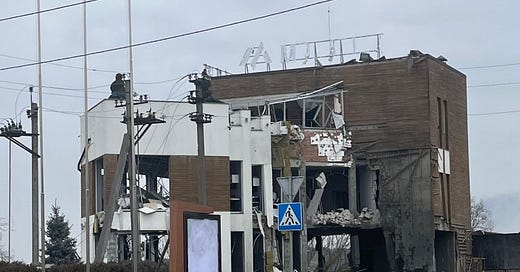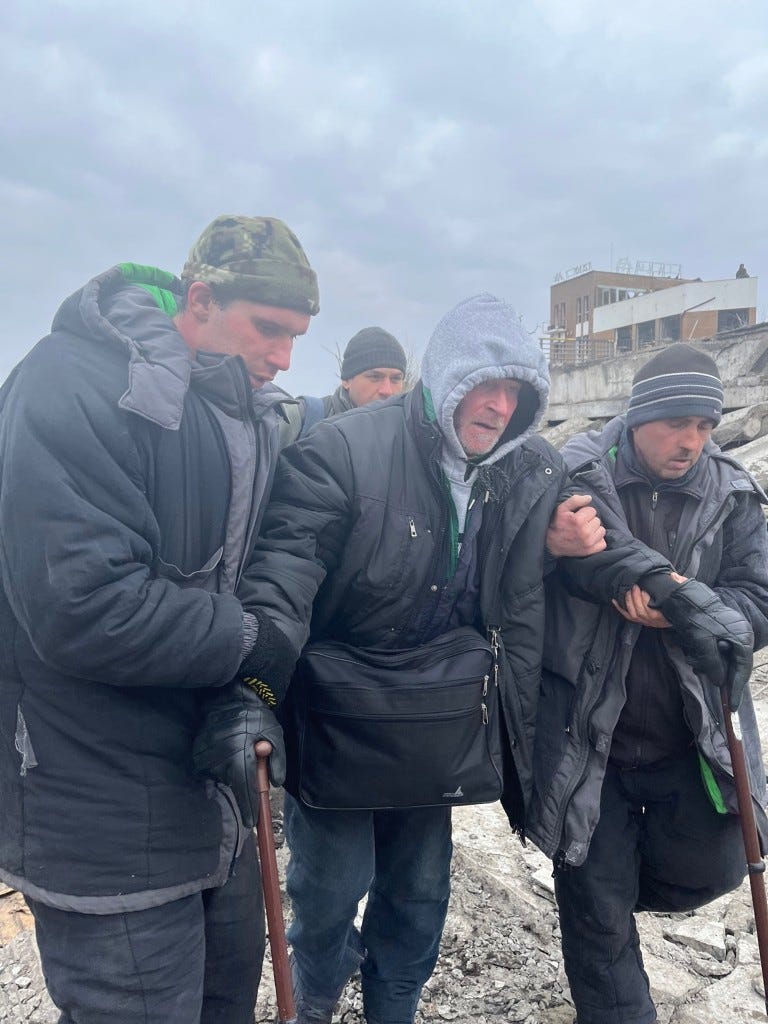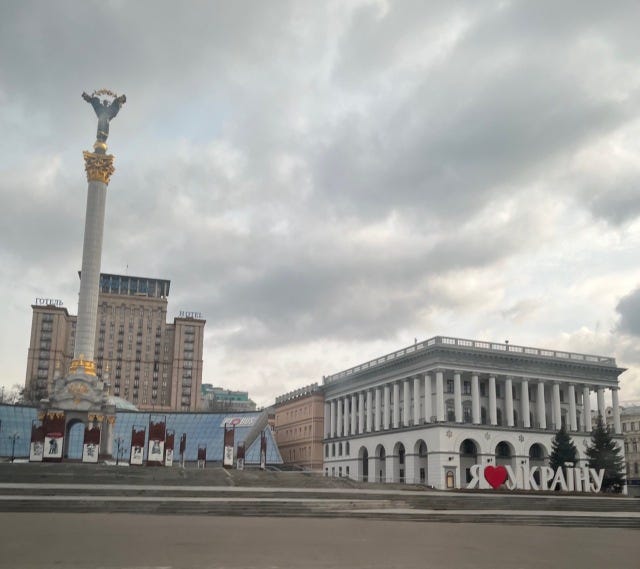DISPATCHES FROM UKRAINE: Medical Angels, Russian Corpses, The Actor Who Took Up Arms to Guard Presidential Buildings and the Tragic Besieging of Kyiv
“The president can't change the country on his own. But what can he do? He can give an example.”
Volodymyr Zelensky
ON THE FRONT LINES WITH UKRAINE’S ‘MEDICAL ANGELS’
They are Ukraine’s “medical angels,’’ a roving band of bright yellow ambulances with blue and khaki signage that rush to the front lines at the first hint of something amiss.
As daylight pierces through the snowy skies Monday, a call comes in for the medics of the Pirogov First Volunteer Mobile Hospital, whose new temporary home is in the heart of downtown Kyiv.
Their male and female workers — many of whom sleep sitting up with their shoes on, ready to run — throw on their flak jackets and helmets and hop into their emergency vehicles, ripping through Kyiv’s barren streets, snaking around chunks of concrete, sirens blaring.
“Some sort of shooting, some sort of attack at a checkpoint,” says PFVMH co-founder and lawyer-turned-medic Gennadiy Druzenko, 49, calmly through a walkie-talkie. “Our people will be there.”
Two PFVMH vehicles soar 30 miles to the northwest edges of Kyiv, where hundreds of shocked and saddened faces idle in the freezing cold with small suitcases.
PFVMH ambulances make only a momentary stop and then high-tail it down one of Ukraine’s deadliest strips toward a dangerous hub of Russian aggression.
Often times, you can smell the war before you can see it: gunpower, smoldering ruins, trash and tires burning somewhere in the nearby plains. The cell service drops out, and bombed and blistered buildings remain on either side of the dusty road, past the “Bucha District” sign and into the Kyiv suburb of Irpin.
Just a few days ago, around 60,000 Ukrainians lived in the town. Now, it’s impossible to know how many are still there, having survived Russia’s persistent aerial bombardment.
Streams of Ukraine’s most vulnerable residents hobble across the ashes of the city’s broken bridge: tiny babies wrapped in blankets, the elderly in wheelchairs and barely able to shuffle with a cane, a sick child engulfed in necklaces of pearl-white medical tubes. They are families without fathers, since the men of the house are mandated to stay and join the fight while their loved ones are trembling and ashen with shock.
A mother and her young daughter, teen son and their family dog climb into the back of our car, shaking so much they cannot speak, cry or pull their stares away from the searing scene.
Another young woman named Elizabeth speaks with wide-open eyes as she mimics the way she and her grandmother ran into the bunker with hands over their heads like something akin to an action movie.
“My babushka and I see this, all this shelling,” she says.
The civilians struggle through their homeland’s ruins, almost oblivious to the scattered shell casings, blown windows and burnt buildings all around. Even with the rumbles of warplanes above, the panic seems to have given way to absolute exhaustion and disbelief.
Each face that passes by seems a mosaic of trauma, heaviness and an anguished hope to make it through. Many residents have gone days without running water, food or electricity as the local death toll mounts.
Irpin is an embodiment of war — in which the innocent always suffer. It is hard to imagine how ordinary people could ever go about their lives in an ordinary way again. The once-sleepy working town has, overnight, been transformed into a jungle of hollowed homes and shattered dreams, of lives that will never be the same again.
CLICK TO READ MORE ABOUT UKRAINE’S FRONTLINE MEDICAL WORKERS
UKRAINE OFFICIAL SAYS RUSSIA WON’T COLLECT SOLDIER CORPSES, BURNING THE ONES IT HAS
As the war in Ukraine escalates and proliferates across much of the embattled country, the number of civilians caught in the crossfire is mounting – along with the number of dead Russian troops.
According to Ukraine’s Ministry of Defense, some 9,000 enemy combatants – an average of 900 per day – have been killed in action since the full-scale invasion ignited some ten days ago. Despite being vastly outnumbered and outgunned, Ukraine forces have put up an unexpected but extraordinary defense.
And many of those Russian corpses remain unaccounted for, a Ukrainian official said Saturday.
“We have asked (Russians) to take the dead bodies, and they have refused to do it,” Volodymyr Goy, Deputy Chief of the Cabinet of the Head of the Presidential Office, noted. “Ukrainian medics are just having to bring those dead bodies to the morgue.’
Goy claimed that the Russians have started to bring in “mobile crematoriums” to dispose of the corpses that they do recover from areas of intense fighting.
“They are most probably just going to say that those people have disappeared, that they don’t know where they are, to avoid paying their families,” he continued. “Because if somebody is officially killed in the war, they (the government) have to pay some remittance to the family. So, to avoid that, they would probably say that he has been lost in some unknown location.”
And, of course, Moscow’s modus operand is to pretend that there is no conflict at all.
While accurate figures of the dead are impossible to come by, in a rare move last week, the Russian Defense Ministry – which has barely reported on its “special liberation military operation” – reluctantly acknowledged that 500 men had died and more than 1500 were wounded. Unconfirmed reports this past week suggested that leaders of the Orthodox Church in Ukraine, still under the thumb of the Moscow Patriarchate, offered to assist in the return of the dead, although it isn’t evident that such an appeal has been put into play.
Moreover, Kyiv’s top-brass are releasing names and frightened faces of the killed and captured as part of its overall “Look for Your Own” strategy to blunt the Kremlin’s skewed propaganda and force the Russian population to address the true nature of their leadership’s operation.
Last week, the Ukrainian government launched the grim https://200rf.com website featuring graphic photos and footage of Russians – dead and alive – along with a search bar for anyone to look up the name of a loved one who may have disappeared into the dark void of the war theater.
“This site was created by representatives of the Ministry of Internal Affairs of Ukraine. On it, you will find information about captured and killed Russian soldiers in Ukraine since the beginning of the occupation. Here we will promptly post photos and videos that we receive from the battlefield,” reads the opening message. “If your relatives or friends are in Ukraine and participate in the war against our people – here you can get information about their fate. Unfortunately, it is difficult to identify a lot of those killed. We deliberately post these photos and videos; you may recognize someone by indirect signs. Information is updated constantly.”
CLICK TO READ MORE ABOUT THE FATE OF RUSSIAN FIGHTERS
UKRAINIAN ACTOR WHO PLAYED SOLDIER TAKES UP ARMS VS. RUSSIANS
For Roman Matsiyta, life went from reel to real in the dark hours between dusk and dawn one day last month.
The 45-year-old Ukrainian actor-musician was preparing to celebrate the release of his latest film, “The Narrow Bridge,” a critically acclaimed drama on Amazon Prime that centers on a talented artist named Kiril. The main character, played by Matsiyta, has his life turned upside down when invaders attack his beloved country, compelling him to swap a paintbrush for a rifle.
Little did Matsiyta know that, while filming in and around Ukraine’s capital of Kyiv a couple of years ago, life would soon jarringly imitate art.
“I have acted in the movies many times, in war movies as a soldier, a character in the wars. But I never thought I would be acting like this in real life,” Matsiya recently said, cradling his gun next to sandbags piled in the frozen air outside of the presidential buildings in the heart of Kyiv. “But our military needs all of us.”
The actor said that unlike his Kiril character, it was not an eternal struggle for him to abandon his flute for a firearm to fight a real enemy.
“I woke up to the sound of explosions, and everyone knew it had begun, and I was ready to fight,” Matsiyta said of the Russian invasion of his country. “Immediately, I went out to find out how I could sign up to fight.
“There were many people like myself trying to be useful somehow or somewhere. After several days, we were accepted into the Territorial Defenses. We received our weapons and went forth to support however we could.”
The Territorial Defense Forces was founded in 2014 after Ukraine’s Maidan Revolution, which saw President Viktor Yanukovych, an ally of Russian President Vladimir Putin, topple. The revolution was followed by Russia retaliating with the annexation of Crimea and backing pro-Russian separatists to invade eastern Ukraine.
In the TD’s early years, tens of thousands of volunteers signed on to the light-infantry, military defense outfit. The number ascended in recent months as tensions with Moscow burgeoned amid a troop buildup around Ukraine’s border. But in the nearly two weeks since the Russian takeover, the number of recruits has soared to up to 2 million.
CLICK TO READ MORE ABOUT THE ACTOR TURNED FIGHTER
THE FATE OF KYIV IN BALANCE AS MILITARY GOVERNOR WARNS SUBURBS UNDER ATTACK AMID BURGEONING HUMANITARIAN CRISIS
Mothers wrap their small children in blankets, their lives reduced to plastic bags overstuffed with clothes and documents. For some 15,000 residents, home is a subterranean subway station scattered around Kyiv. Above ground, the city once flushed with three million people is reduced to a shell of its former self, speckled mostly with gun-toting guards, heavy cement chunks to serve as barriers and checkpoints every few blocks along the road.
Occasionally, older women trudge alone up the cobblestone hills, carrying heavy bags of supplies as warnings to stock up and hunker down increase.
The rumble of shells booming in the distance and of air-raid sirens screeching has become jarringly familiar as the full-scale Russian invasion enters its tenth day. But some Kyiv officials claim the worst is yet to come as the push to the capital intensifies.
“From the very first hours of this invasion, the Russian invaders crossed from the (Belarus) border to the Chernobyl site, entering Kyiv province and heading toward Kyiv (the capital),” Oleksii Kuleba, the Head of Military Administration of Kyiv Province, which is separate to the governing administration of the country’s capital, said on Friday afternoon. “So, from the very first minute of this war, we have been under a big risk that the Russians will quickly reach the capital. This is their key goal to take it over. It is only due to our forces stopping the fast movements of their leading units as to why they have not entered.”
Nonetheless, the oblast has already suffered a barrage of Russian rockets and missiles, laying waste to critical infrastructure and civilian dwellings as the Russian Armed Forces expand their foothold in pockets of the province. Notably, Russians seized the Chernobyl Exclusion Zone 60 miles north of the capital last week, sending a shudder through Ukrainians and much of the international community, given its nuclear power infrastructure.
While steadfastly determined to keep repelling the enemy back, it remains unclear how long the vastly outnumbered and outgunned Ukrainian resistance can hold the line.
“From Chernobyl, and from the Russian side, we are seeing more and more units moving in every day. This is everything from new units, armored personnel carriers, vehicles, tanks and foot soldiers,” Kuleba continued. “This has resulted in some very grave, very serious battles taking place in the Zhytomyr highway across Kyiv.”
This week, the bridge Stoyanka – poised on the central route west out of the capital – was hit, severing the supply line and stopping civilians from easily leaving the conflict-ravaged region. Kuleba also lamented that several of the oblast’s most quaint tourist and recreational attraction towns had been bombed in recent days.
For one, the 19th century-crafted town of Irpin has been caught in the crossfire of attacks aimed at choking the capital, with scores of civilian homes in the northwest enclave decimated. In addition to Irpen, Russians have been aggressing into neighboring Kyiv suburbs of Buch, Vorzel, Hostomel and Borodianka. This week, a kindergarten in Vorzel – where 50 children were sheltering – was struck by enemy fire, Ukrainian officials claim. Periodic shells rain down in Hostomel, and Borodianka infrastructure and housing were severely damaged in a string of poundings from the air.
“These towns have become targets of the attack aimed at the capital of Ukraine,” he said, almost pleadingly. “These towns have been seriously ruined, many homes destroyed.”
All this has induced something of a humanitarian crisis, officials noted.
CLICK TO READ MORE ABOUT THE TRAGEDY OF KYIV OBLAST
For those interested in learning more about the aftermath of war, please pick up a copy of my latest book “Only Cry for the Living: Memos from Inside the ISIS Battlefield.”
Also if you want to support small business:
And also now available Down Under!
Thanks again for your support. Follow me on Instagram and Twitter for more updates. Please consider a paid subscription to help me continue to do this work.








